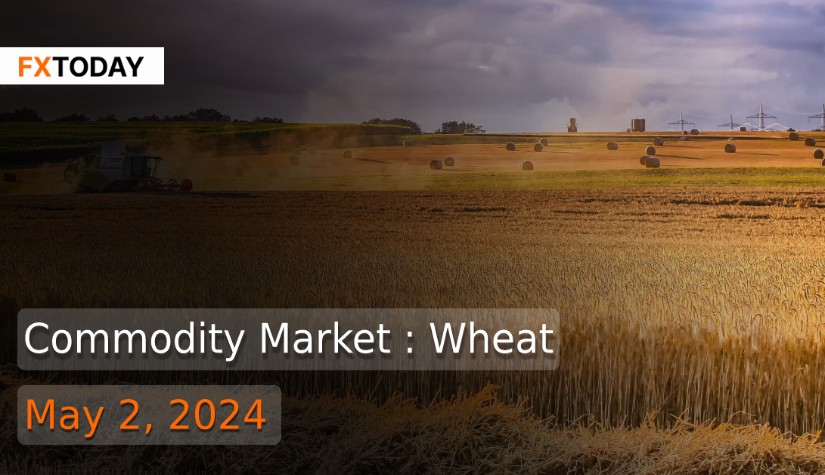Wheat Market Sees Declines Amid Global Weather, Limited Price Upside Predicted
The wheat market saw declines, influenced by technical factors and a disregard for global weather issues. Dry conditions persisted in parts of the southwestern U.S. Plains, Australia, and the Black Sea region, while excessive rainfall affected areas of the eastern Midwest, Delta, and western Europe. Rainfall is likely to cause delays in spring wheat planting in the northern U.S. Plains and Canada, although improved soil moisture is seen as a positive. However, any potential price increases are expected to be limited by sluggish export demand for U.S. wheat, with Russia and Ukraine maintaining dominance in the global market. Brazil's ANEC forecasts slightly lower April wheat exports compared to previous estimates.
The USDA's weekly sales figures indicate a decline in wheat usage for flour production in 2023, with lower domestic consumption and increased ending stocks projected for the 2023/24 marketing year. The global outlook for wheat includes larger supplies, consumption, and exports, with reduced ending stocks. Russia and Ukraine are expected to increase exports, while the EU faces competition from the Black Sea region. Overall, global ending stocks for 2023/24 are forecast to be lower compared to the previous year, potentially reaching the lowest level since 2015/16.
As the 2023/24 marketing year enters its final six weeks, many buyers are securing purchases for June and July shipments, shifting focus to the new crop U.S. wheat sales for 2024/25, which are showing a faster ramp-up compared to the previous year. Throughout 2023/24, market conditions favored buyers, with U.S. wheat FOB export prices dropping 15% on average due to competition from the Black Sea, particularly Russian wheat, which remains the cheapest globally. Despite the decline in prices, exports for two U.S. wheat classes, soft red winter (SRW) and hard red spring (HRS), have increased significantly, with China importing over 1.2 million metric tons of SRW and HRS sales up by 13%. However, this positive performance does not offset the substantial decline in exports of hard red winter (HRW) and soft white (SW) wheat.
Expectations are for the sales pace in 2023/24 to further decline as customers seek shipments for June and July delivery. Despite increased exports for certain classes, the USDA projects wheat exports to reach their lowest level since 1971/72, with total commitments below projections. However, the outlook for the new crop year, 2024/25, is more optimistic, with buyers taking advantage of lower prices and securing early shipments. By April 18, known outstanding sales for 2024/25 reached 2.1 million metric tons, significantly ahead of last year's pace.
South Korea stands out as the top U.S. wheat buyer, with a significant increase in purchases compared to the previous year. Additionally, other major new crop buyers such as the Philippines, Mexico, and Japan have also increased their purchases significantly compared to last year. Some of these increases are attributed to customers' need for product and shipment consistency, as well as the advantage of more competitive pricing.
Wheat futures saw a modest rise last week, indicating market attention toward weather concerns in the Northern Hemisphere. Despite being at their lowest since spring 2021, there's a suggestion that the consistent price decline might be slowing down. Reports attribute this rally to factors like the Russian attacks on Ukrainian infrastructure, dry weather affecting U.S. hard red winter wheat areas, and the potential for significant wheat imports by India due to dwindling government-owned stocks. However, it's uncertain whether these factors will lead to a sustained price increase in the long term.
The price of wheat recently touched a significant support level at $597.10 and displayed temporary bullish movement. However, the stochastic indicator suggests a loss of positive momentum, indicating potential for a return to bearish trading. The next main target for downward movement is identified at $583.50, with the bearish trend expected to persist unless the price surpasses and holds above $614.10. The anticipated trading range for this period is between $590.00 support and $614.00 resistance.
Data for Technical Analysis (1D) CFD US Wheat Futures - Jul 24 (ZWN4)
Resistance : 606.33, 609.92, 615.75
Support : 594.67, 591.08, 585.25
1D Outlook
Source: TradingView
Buy/Long 1 If the support at the price range 584.67 - 594.67 is touched, but the support at 594.67 cannot be broken, the TP may be set around 607.50 and the SL around 579.67, or up to the risk appetite.
Buy/Long 2 If the resistance can be broken at the price range of 606.33 - 616.33, TP may be set around 622.15 and SL around 589.67, or up to the risk appetite.
Sell/Short 1 If the resistance at the price range 606.33 - 616.33 is touched, but the resistance 606.33 cannot be broken, the TP may be set around 592.25 and the SL around 621.33, or up to the risk appetite.
Sell/Short 2 If the support can be broken at the price range of 584.67 - 594.67, TP may be set around 576.80 and SL around 611.33, or up to the risk appetite.
Pivot Points May 2, 2024 02:53AM GMT
|
Name
|
S3
|
S2
|
S1
|
Pivot Points
|
R1
|
R2
|
R3
|
|---|---|---|---|---|---|---|---|
| Classic | 577 | 585.25 | 592.25 | 600.5 | 607.5 | 615.75 | 622.75 |
| Fibonacci | 585.25 | 591.08 | 594.67 | 600.5 | 606.33 | 609.92 | 615.75 |
| Camarilla | 595.06 | 596.45 | 597.85 | 600.5 | 600.65 | 602.05 | 603.44 |
| Woodie's | 576.38 | 584.94 | 591.63 | 600.19 | 606.88 | 615.44 | 622.13 |
| DeMark's | - | - | 588.75 | 598.75 | 604 | - | - |
Sources: Western Producer, U.S. Wheat Associates, Economies.com
















